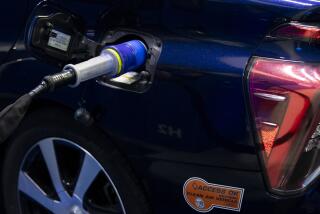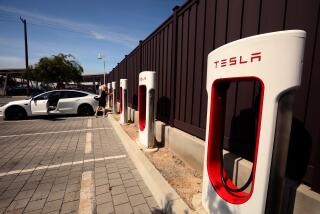Natural gas: It’s the alternative alternative
Gasoline-electric hybrids are the glamorous celebrities of the automotive world these days, but there are other choices for those who want to drive green.
One of the best could be cars or trucks that run on compressed natural gas, or CNG.
They run far cleaner than gasoline or diesel vehicles, their fuel costs about 33% less and most of the stuff is natural gas produced in the U.S., helping reduce dependency on foreign oil.
Unfortunately, there aren’t many publicly available CNG filling stations outside of California. The Golden State has about 100 such locations, including 60 within 100 miles of downtown Los Angeles. Many of them, however, require a special key card for admittance, so CNG vehicle drivers can’t just drop in.
The newest is in Carson. It was opened last month by the Sanitation Districts of Los Angels County, an agency that also operates a public CNG station at a recycling facility in Whittier.
The Carson station, at Figueroa Street and Sepulveda Boulevard, is expected to serve business, government and taxi fleets that use older, mass-market CNG vehicles such as the 2004 Ford Crown Victoria sedan and the 2005 GMC Sierra and Chevrolet Silverado pickups.
There are a number of CNG vehicles out there that private companies have converted from standard gasoline cars and trucks. The sanitation agency, spokesman Basil Hewitt said, wants to switch its entire fleet of 120 vehicles to CNG by 2012.
Even as CNG fleets chug along, the number of models available to everyday drivers is dropping.
For a while it appeared that automakers were going to start jumping on the bandwagon. In 2004 there were nine models available from General Motors Corp., Ford Motor Co. and Honda Motor Co.: three full-size pickup trucks, two compact cars, three vans and a full-size sedan.
But all except Honda have dropped CNG vehicles from their lineups. The manufacturers blame the dearth of publicly available stations, the lack of public knowledge about natural gas vehicles and -- until the last few years -- the relatively low cost of oil and gasoline.
The lone 2007 model CNG passenger vehicle marketed by a major automaker is Honda’s Civic GX, which is sold only in California and New York and carries a fairly hefty price tag of $25,185. That compares with $22,600 for the base Civic hybrid and $15,400 for the base DX gasoline model.
Not to worry: Whatever compression a would-be CNG driver might feel in the wallet can be offset by some good old-fashioned government incentives.
First, the natural gas Civic qualifies for a $4,000 federal tax credit, versus $2,100 for the hybrid model.
In addition, if time is money, the GX offers another advantage for anyone with a tough commute: It is the only car sold in California that still qualifies for a sticker permitting it to use the state’s diamond lanes with only one occupant. All stickers for hybrids have been distributed.
There’s still that issue of where to fuel up. But consider that Honda dealers sell or lease a home natural gas fuel maker with the GX. And after a $2,000 South Coast Air Quality Management District subsidy and a $1,000 federal tax credit, the thing is almost free: The $3,500 model that installs in the owner’s garage ends up costing $500.
The device, called Phill and made by FuelMaker Corp. of Toronto, is capable of compressing enough natural gas each day to fill the GX’s 8-gallon tank (yep, only 8, but the car is rated at 28 miles per gallon in the city and 39 on the highway, so it can travel 200 to 300 miles on a tankful).
CNG fuel costs about $2 a gallon at a public station but runs about $1.20 a gallon when produced with the home fuel maker.
CNG vehicle drivers, especially those planning long trips, can find the locations of every CNG filling station in the nation on the Energy Department’s alternative fuel station locator website at https://afdcmap2.nrel.gov/locator/findpane.asp.
-- John O’Dell
*
THE ROAD AHEAD
Auto Club turning used batteries into education
The Automobile Club of Southern California is urging motorists to get the lead out -- of their garages, yards and storage sheds, wherever they have discarded their used vehicle, boat or airplane batteries.
The club will donate $1.50 to Surfbus, a group that provides marine science education to low-income children, for each battery dropped off at one of its 44 collection sites April 16-22. (The list is online at www.aaa.com; go to the automotive home page.)
Last year’s haul of 2,097 batteries, the club says, removed 44,000 pounds of lead that could otherwise foul the environment.
Highway One
Coming Wednesday to The Times’ weekly auto section:
Rumble Seat: Dan Neil drives the Ferrari 599 GTB.
Throttle Jockey: Susan Carpenter compares and contrasts the Kawasaki ZX-6R and the Honda CBR600RR.
Online: latimes.com/lawheels.
*
OVERHEARD
Rumblings from two of the Not-as-Big Three
“Overall, this was a good month for Ford except in one respect -- when we compare it to a year ago.”
-- George Pipas, Ford Motor Co.’s chief sales analyst, announcing a 9% year-over-year drop in its March vehicle sales.
*
“If Chrysler is finally led before the divorce court judge, we would be very grateful. But what happens if you don’t find a new bridegroom or if he demands an inappropriately high dowry?”
-- Henning Gebhardt, head of German equities for mutual fund manager DWS, at Daimler-Chrysler’s annual shareholder meeting a day before would-be groom Kirk Kerkorian bid $4.5 billion for Chrysler Group.
*






